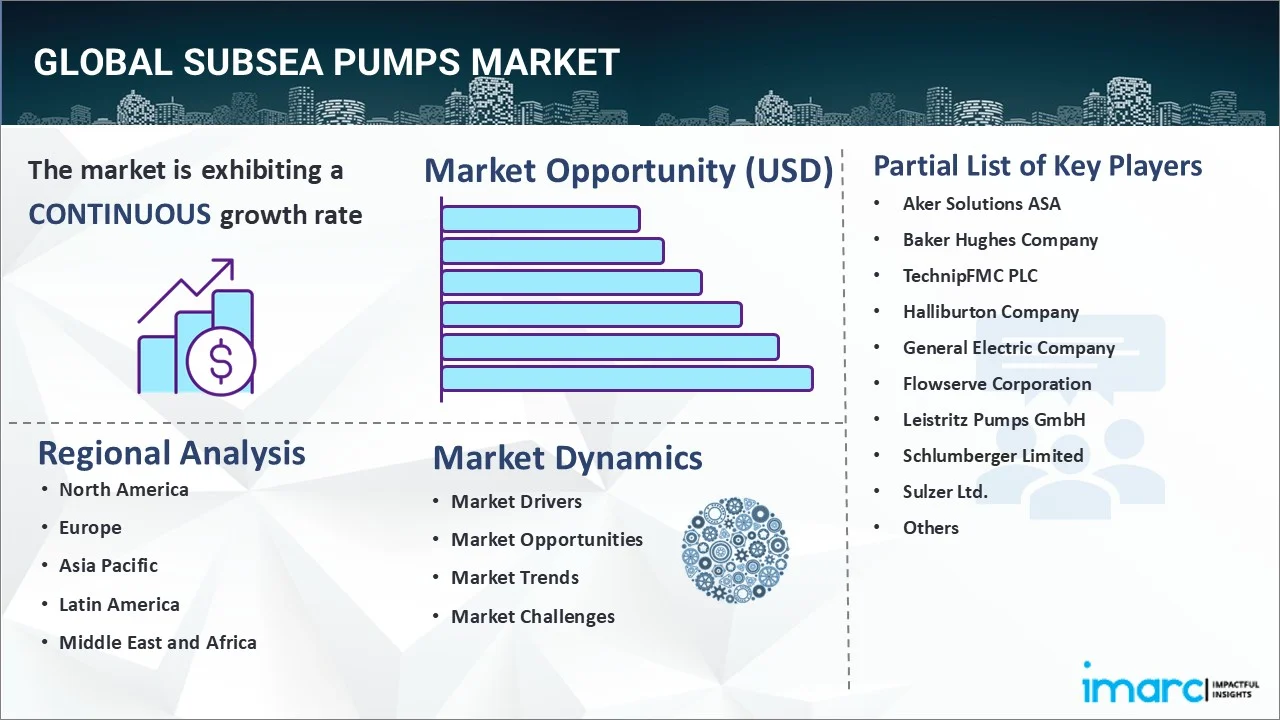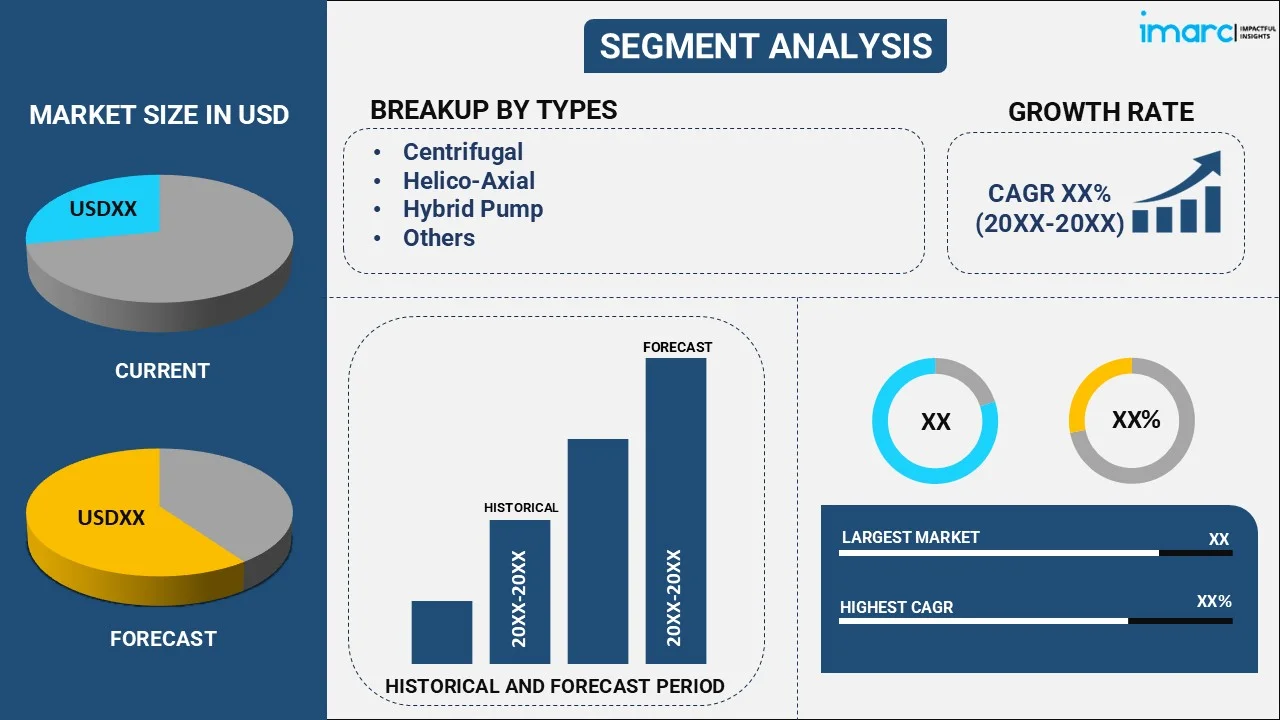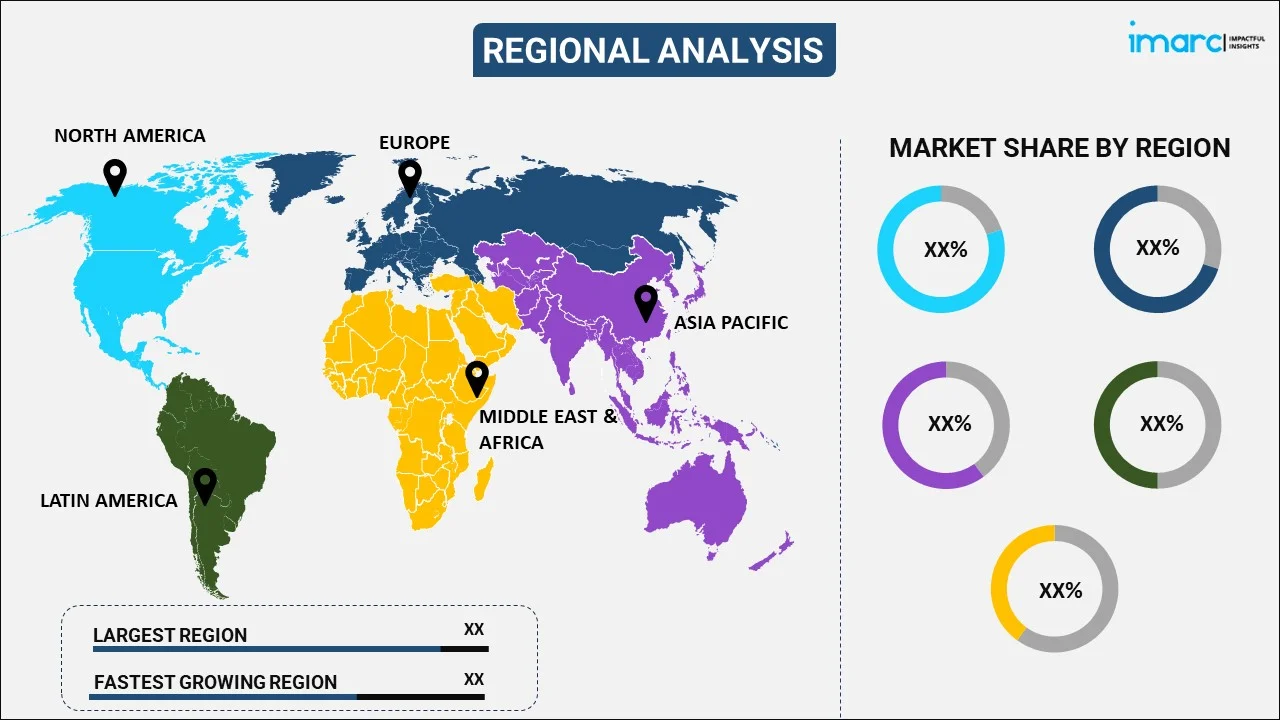
Subsea Pumps Market Report by Type (Centrifugal, Helico-Axial, Hybrid Pump, Twin Screw, Co-Axial, ESP (Electrical Submersible Pump)), Application (Subsea Boosting, Subsea Separation, Subsea Injection, Subsea Gas Compression), and Region 2025-2033
Global Subsea Pumps Market:
The global subsea pumps market size reached USD 1.87 Billion in 2024. Looking forward, IMARC Group expects the market to reach USD 3.04 Billion by 2033, exhibiting a growth rate (CAGR) of 5.5% during 2025-2033. The global market is primarily driven by continual technological advancements, the expansion and modernization of aging infrastructure, and a strong focus on cost efficiency and operational excellence, and the increasing global demand for energy and stringent safety and environmental standards.
|
Report Attribute
|
Key Statistics
|
|---|---|
|
Base Year
|
2024 |
|
Forecast Years
|
2025-2033
|
|
Historical Years
|
2019-2024
|
| Market Size in 2024 | USD 1.87 Billion |
| Market Forecast in 2033 | USD 3.04 Billion |
| Market Growth Rate 2025-2033 |
5.5%
|
Subsea Pumps Market Analysis:
- Major Market Drivers: The escalating demand for offshore oil and gas exploration activities is primarily driving the market for subsea pumps. The market's expansion is further supported by the depletion of onshore reserves and the consequent shift to more challenging offshore environments, necessitating advanced pumping solutions.
- Key Market Trends: The adoption of more energy-efficient and environmentally sustainable pumping solutions coupled with the increasing offshore exploration activities, the need for efficient extraction from deepwater reserves, and the aging of offshore infrastructure are propelling the adoption of subsea pumps.
- Competitive Landscape: Some of the prominent companies in the market include Aker Solutions ASA, Baker Hughes Company, TechnipFMC PLC, Halliburton Company, General Electric Company, Flowserve Corporation, Leistritz Pumps GmbH, Schlumberger Limited, Sulzer Ltd., SPX Corporation, Hayward Tyler Group PLC, National Oilwell Varco, Oceaneering International, Framo AS, and ITT Bornemann GmbH, among many others.
- Geographical Trends: According to the subsea pumps market dynamics, the Middle East and Africa exhibit a clear dominance in the market. The region is a major hub for the oil and gas industry, with countries like Saudi Arabia, UAE, and Nigeria being significant producers. Subsea pumps are essential for enhancing oil recovery rates from offshore fields, which drives the product demand in the region.
- Challenges and Opportunities: High costs associated with the development of subsea pumps, and supply chain disruptions are hampering the market growth. However, the increasing exploration and production activities in deepwater and ultra-deepwater fields present opportunities for subsea pump manufacturers. These activities require pumps capable of enhancing production rates and recovering reserves efficiently.

Subsea Pumps Market Trends:
Increasing Offshore Oil and Gas Exploration
As conventional oil and gas reserves on land become scarcer, energy companies are shifting their focus to offshore reserves, which are often located in deeper and more challenging environments. For instance, as of 2021, the offshore oil and gas industry was responsible for around 30% of world crude oil output. Also, in July 2024, CNOOC made a "major exploration breakthrough" in a Mesozoic buried hill in Bohai Bay by discovering a new oil and gas field offshore China. The LK7-1-1 exploratory well was bored and finished at a depth of roughly 4,400 m, encountering 76 m of oil and gas pay zones. The pumps play a pivotal role in maintaining the flow of hydrocarbons from these subsea wells to the surface. These factors are further contributing to the subsea pumps’ market share.
Growing Focus on Deepwater Reserves
The growing exploration and development of deepwater and ultra-deepwater oil and gas reserves are driving the demand for specialized equipment. For instance, in the Permian Basin, one of the most important basins in terms of crude oil, production from older wells begun to fall, leaving limited room for discovery in these areas. As a result, the oil and gas sector is moving its focus to deeper locations in the quest for oil and gas to meet the rising demand. The expansion into these challenging environments drives the need for advanced subsea pumping solutions. These factors are further positively influencing the subsea pump market forecast.
Risings Investments in Infrastructure Development
Emerging markets in various regions are witnessing increased investment in offshore oil and gas infrastructure. For instance, in May 2024, Equinor and its Troll partners announced to invest nearly $1.13 billion (NOK 12 billion) to expand the gas infrastructure in the Troll West gas region offshore Norway. Elevating investment supports the construction of offshore infrastructure such as drilling platforms, pipelines, subsea processing units, and floating production storage and offloading (FPSO) vessels. Subsea pumps are integral components of this infrastructure, ensuring the efficient flow of fluids and supporting operational reliability. This is further bolstering the subsea pumps market revenue.
Global Subsea Pumps Industry Segmentation:
IMARC Group provides an analysis of the key trends in each segment of the market, along with forecasts at the global and regional levels for 2025-2033. Our report has categorized the market based on type and application.
Breakup by Type:

- Centrifugal
- Helico-Axial
- Hybrid Pump
- Twin Screw
- Co-Axial
- ESP (Electrical Submersible Pump)
Helico-axial accounts for the majority of the market share
The report has provided a detailed breakup and analysis of the market based on the type. This includes centrifugal, helico-axial, hybrid pump, twin screw, co-axial, and ESP (electrical submersible pump). According to the report, helico-axial represented the largest segment.
According to the subsea pumps market outlook, helico-axial pumps are dominating the market as they are particularly designed for subsea applications involving multiphase flows, where gas, oil, and water mixtures are present. Their unique design combines helical rotor blades and axial flow patterns, enabling them to efficiently handle high gas-to-liquid ratios. This capability is crucial in deepwater environments where gases are often present in extracted fluids. In addition to this, their robustness and reliability under challenging conditions, such as high pressures and varying flow rates, make them the go-to choice in many offshore operations.
Breakup by Application:
- Subsea Boosting
- Subsea Separation
- Subsea Injection
- Subsea Gas Compression
Subsea boosting holds the largest share in the industry
A detailed breakup and analysis of the market based on the application have also been provided in the report. This includes subsea boosting, subsea separation, subsea injection, and subsea gas compression. According to the report, subsea boosting accounted for the largest market share.
According to the subsea pumps market overview, as the largest segment, subsea boosting involves increasing the pressure of the hydrocarbons extracted from subsea wells to ensure efficient transportation to the surface or processing facilities. This is particularly crucial in deepwater and ultra-deepwater environments where natural reservoir pressure is insufficient for lifting the oil to the surface. Subsea boosting systems use pumps to overcome these challenges, enhancing the flow rate and ensuring the economic viability of deepwater operations. They are essential in fields with long tiebacks to host facilities and in reservoirs with low pressure.
Breakup by Region:

- North America
- Europe
- Asia Pacific
- Middle East and Africa
- Latin America
Middle East and Africa leads the market, accounting for the largest subsea pumps market share
The market research report has also provided a comprehensive analysis of all the major regional markets, which include North America, Europe, Asia Pacific, the Middle East and Africa, and Latin America. According to the report, Middle East and Africa accounted for the largest market share.
According to the subsea pumps market statistics, Middle East and Africa, being the largest segment, enhances significant offshore oil and gas reserves, particularly in countries, such as Saudi Arabia, Nigeria, Angola, and the UAE. The Middle East and Africa are known for their large-scale offshore projects and deep-water explorations, necessitating advanced subsea pumping technologies. For instance, in July 2024, Saipem secured two major offshore projects in Saudi Arabia through its established Long-Term Agreement (LTA) with Saudi Aramco. The sum of these projects estimated USD 500 million total highlights Saipem's strategic place in the world's energy industry. Additionally, the region's strategic focus on maintaining its dominance in the global oil market fuels continual investments in offshore technologies, including subsea pumps.
Competitive Landscape:
Key players in the market are actively engaged in a variety of strategic initiatives to strengthen their market positions. These include investments in research and development to innovate and improve the efficiency, reliability, and longevity of their products, catering to the evolving needs of deepwater and ultra-deepwater operations. Many are forming strategic partnerships and collaborations with oil and gas companies to tailor their offerings to specific project requirements. Additionally, there's a significant focus on expanding global reach through mergers, acquisitions, and establishing new operational bases in strategic locations. Companies are also increasingly committing to sustainability, integrating environmental considerations into their product designs and operations to align with the broader industry shift towards cleaner and more responsible energy production.
The market research report has provided a comprehensive analysis of the competitive landscape. Detailed profiles of all major companies have also been provided. Some of the key players in the market include:
- Aker Solutions ASA
- Baker Hughes Company
- TechnipFMC PLC
- Halliburton Company
- General Electric Company
- Flowserve Corporation
- Leistritz Pumps GmbH
- Schlumberger Limited
- Sulzer Ltd.
- SPX Corporation
- Hayward Tyler Group PLC
- National Oilwell Varco
- Oceaneering International
- Framo AS
- ITT Bornemann GmbH
(Please note that this is only a partial list of the key players, and the complete list is provided in the report.)
Subsea Pumps Market Recent Developments:
- June 2024: TechnipFMC chose Sulzer Flow Equipment to work with on creating new subsea CO2 pump solutions for emerging technologies.
- April 2024: SLB launched two sophisticated artificial lift systems: the Reda Agile compact wide-range electric submersible pump (ESP) system, and the rodless Reda PowerEdge electric submersible progressive cavity pump (ESPCP).
- February 2024: Curtiss-Wright Corporation and PETRÓLEO BRASILEIRO S.A. - PETROBRAS signed a Technology Cooperation Agreement to design, manufacture, test, and support a Subsea Canned Motor Boosting System.
Subsea Pumps Market Report Scope:
| Report Features | Details |
|---|---|
| Base Year of the Analysis | 2024 |
| Historical Period | 2019-2024 |
| Forecast Period | 2025-2033 |
| Units | Billion USD |
| Scope of the Report | Exploration of Historical Trends and Market Outlook, Industry Catalysts and Challenges, Segment-Wise Historical and Predictive Market Assessment:
|
| Types Covered | Centrifugal, Helico-Axial, Hybrid Pump, Twin Screw, Co-Axial, ESP (Electrical Submersible Pump) |
| Applications Covered | Subsea Boosting, Subsea Separation, Subsea Injection, Subsea Gas Compression |
| Regions Covered | Asia Pacific, Europe, North America, Latin America, Middle East and Africa |
| Companies Covered | Aker Solutions ASA, Baker Hughes Company, TechnipFMC PLC, Halliburton Company, General Electric Company, Flowserve Corporation, Leistritz Pumps GmbH, Schlumberger Limited, Sulzer Ltd., SPX Corporation, Hayward Tyler Group PLC, National Oilwell Varco, Oceaneering International, Framo AS, ITT Bornemann GmbH, etc. |
| Customization Scope | 10% Free Customization |
| Post-Sale Analyst Support | 10-12 Weeks |
| Delivery Format | PDF and Excel through Email (We can also provide the editable version of the report in PPT/Word format on special request) |
Key Benefits for Stakeholders:
- IMARC's report offers a comprehensive quantitative analysis of various market segments, historical and current market trends, market forecasts, and dynamics of the subsea pumps market from 2019-2033.
- The research study provides the latest information on the market drivers, challenges, and opportunities in the global subsea pumps market.
- The study maps the leading, as well as the fastest-growing, regional markets.
- Porter's five forces analysis assists stakeholders in assessing the impact of new entrants, competitive rivalry, supplier power, buyer power, and the threat of substitution. It helps stakeholders to analyze the level of competition within the subsea pumps industry and its attractiveness.
- The competitive landscape allows stakeholders to understand their competitive environment and provides insight into the current positions of key players in the market.
Key Questions Answered in This Report
The global subsea pumps market was valued at USD 1.87 Billion in 2024.
We expect the global subsea pumps market to exhibit a CAGR of 5.5% during 2025-2033.
The expanding oil and gas sector, along with the increasing focus on the development of offshore hydrocarbon reserves, is primarily driving the global subsea pumps market.
The sudden outbreak of the COVID-19 pandemic had led to the implementation of stringent lockdown regulations across several nations, resulting in the temporary halt in the development of various offshore fields, thereby limiting the demand for subsea pumps.
Based on the type, the global subsea pumps market has been segregated into centrifugal, helico-axial, hybrid pump, twin screw, co-axial, and ESP (Electrical Submersible Pump). Among these, helico-axial type represents the largest market share.
Based on the application, the global subsea pumps market can be segmented into subsea boosting, subsea separation, subsea injection, and subsea gas compression. Currently, subsea boosting accounts for the majority of the total market share.
On a regional level, the market has been classified into North America, Asia Pacific, Europe, Latin America, and Middle East and Africa, where Middle East and Africa currently dominates the global market.
Some of the major players in the global subsea pumps market include Aker Solutions ASA, Baker Hughes Company, TechnipFMC PLC, Halliburton Company, General Electric Company, Flowserve Corporation, Leistritz Pumps GmbH, Schlumberger Limited, Sulzer Ltd., SPX Corporation, Hayward Tyler Group PLC, National Oilwell Varco, Oceaneering International, Framo AS, ITT Bornemann GmbH, etc.
Need more help?
- Speak to our experienced analysts for insights on the current market scenarios.
- Include additional segments and countries to customize the report as per your requirement.
- Gain an unparalleled competitive advantage in your domain by understanding how to utilize the report and positively impacting your operations and revenue.
- For further assistance, please connect with our analysts.
 Request Customization
Request Customization
 Speak to an Analyst
Speak to an Analyst
 Request Brochure
Request Brochure
 Inquire Before Buying
Inquire Before Buying




.webp)




.webp)












